
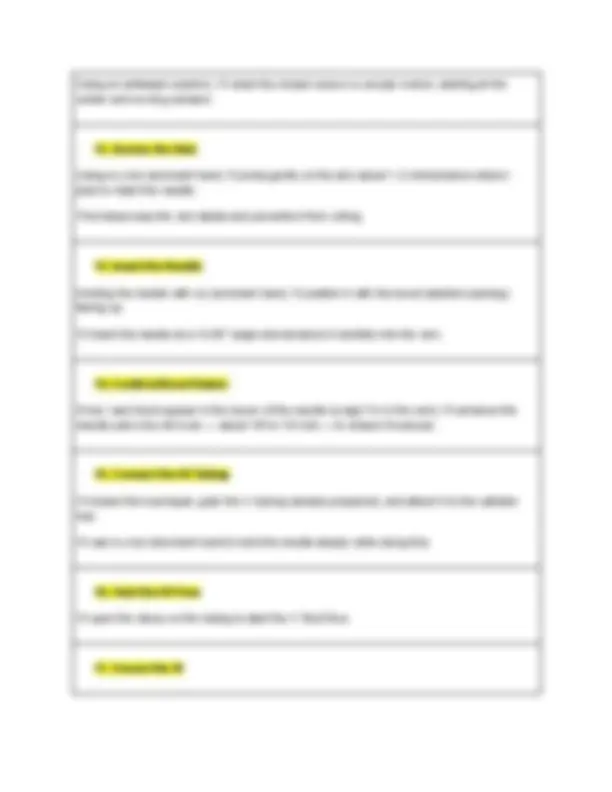
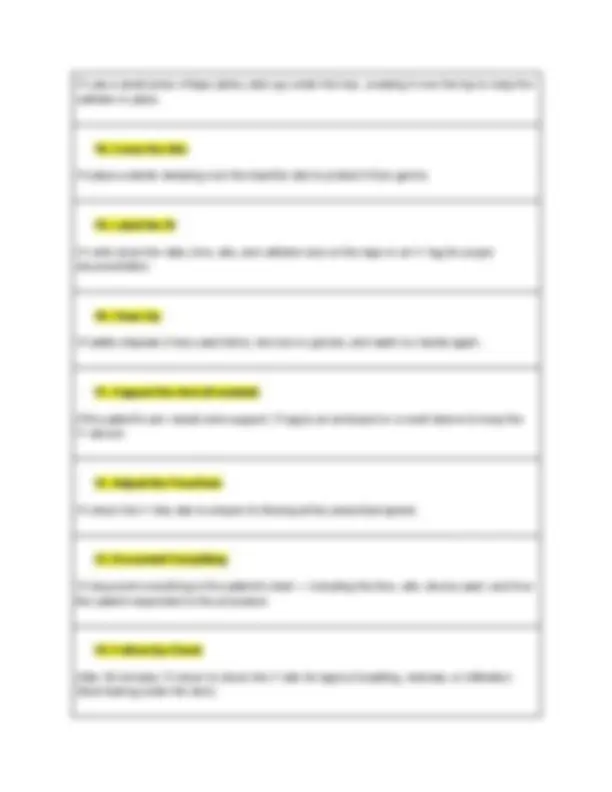
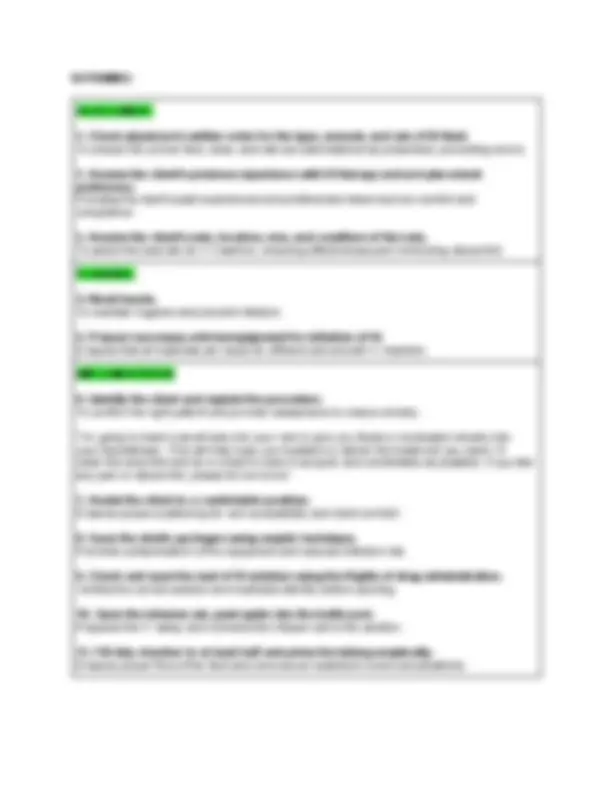
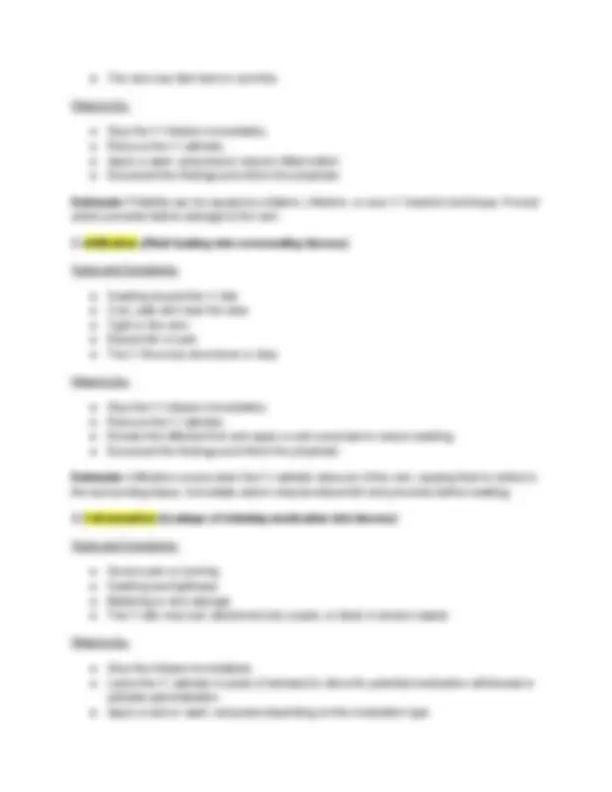
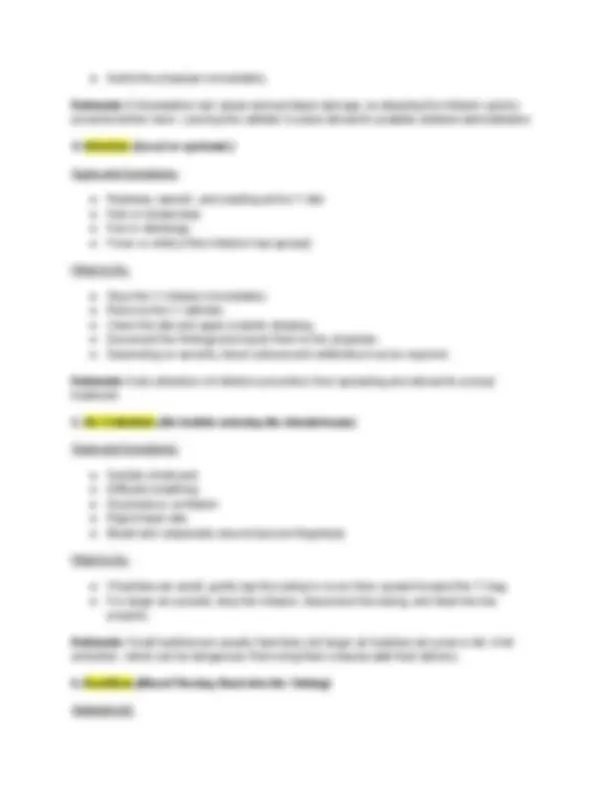
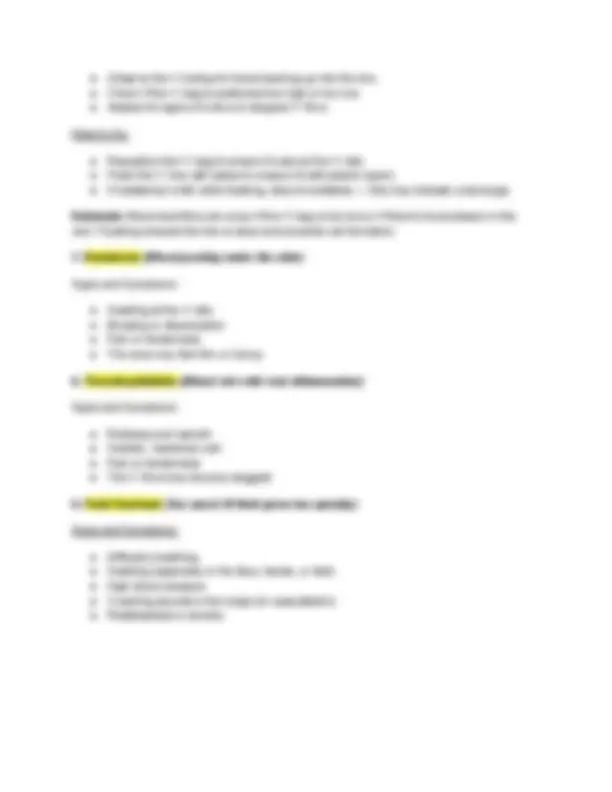


Study with the several resources on Docsity

Earn points by helping other students or get them with a premium plan


Prepare for your exams
Study with the several resources on Docsity

Earn points to download
Earn points by helping other students or get them with a premium plan
Community
Ask the community for help and clear up your study doubts
Discover the best universities in your country according to Docsity users
Free resources
Download our free guides on studying techniques, anxiety management strategies, and thesis advice from Docsity tutors
level 2 BSN - Intravenous Infusion Checklist and Common IV therapy comlplications.
Typology: Cheat Sheet
1 / 12

This page cannot be seen from the preview
Don't miss anything!







1. Gather Your Supplies
First, I’ll collect all the equipment I need — like the cotton balls with alcohol, dry cotton balls, alcohol for hand hygiene, IV fluid, tape, scissor, tubing, cannula, tourniquet and sterile gloves.
I’ll also double-check the IV solution and any medications added to it to make sure they match the doctor’s orders.
2. Explain the Procedure
Before I begin, I’ll explain the procedure to the patient to help them feel comfortable and informed.
“Good morning, ma’am/sir! I’m Iyalyn, your student nurse today. I’ll be inserting an IV to give you fluids or medication directly into your vein, which helps your body absorb it faster.
I’ll clean your arm first, then insert a small needle — you may feel a quick pinch, but I’ll do my best to keep you comfortable. Once the needle is in, I’ll remove it, leaving a soft tube in place.
If you have any questions or feel uncomfortable at any time, please let me know. Your comfort is my priority.”
3. Perform Hand Hygiene
I’ll wash and sanitize my hands to prevent infection.
If the doctor has ordered a numbing cream to help reduce discomfort, I’ll apply a small amount to a few possible insertion sites. (This cream takes some time to work, so I’ll apply it early to give it enough time to take effect before I insert the IV).
4. Prepare the IV Solution and Tubing
I’ll set up the IV tubing by priming it — meaning I’ll fill the tubing with a solution to get rid of any air bubbles.
5. Position the Patient
I’ll help the patient get into a comfortable position — usually Low Fowler's position.
I’ll place a protective towel or pad under their arm to keep the area clean and dry.
6. Choose a Vein
I’ll look for a good vein, usually in the arm. I’ll gently feel the area to find one that’s easy to access.
7. Prepare the Area
If the area is hairy and hospital policy allows it, I’ll trim a small 2-inch section to keep things clean and prevent the dressing from lifting later.
8. Apply the Tourniquet
I’ll tie a tourniquet about 5-6 inches above the chosen vein. This makes the vein swell, making it easier to find and access.
I’ll check the patient’s radial pulse below the tourniquet to make sure blood is still flowing properly.
9. Ask the Patient to Move Their Hand
I’ll ask the patient to open and close their fist a few times. This helps fill the vein with more blood, making it easier to see and feel.
10. Put on Gloves
I’ll put on clean gloves to maintain hygiene.
11. Clean the Skin
I’ll use a small piece of tape (sticky side up) under the hub, crossing it over the top to keep the catheter in place.
18. Cover the Site
I’ll place a sterile dressing over the insertion site to protect it from germs.
19. Label the IV
I’ll write down the date, time, site, and catheter size on the tape or an IV tag for proper documentation.
20. Clean Up
I’ll safely dispose of any used items, remove my gloves, and wash my hands again.
21. Support the Arm (if needed)
If the patient’s arm needs extra support, I’ll apply an armboard or a mesh sleeve to keep the IV secure.
22. Adjust the Flow Rate
I’ll check the IV drip rate to ensure it’s flowing at the prescribed speed.
23. Document Everything
I’ll document everything in the patient’s chart — including the time, site, device used, and how the patient responded to the procedure.
24. Follow-Up Check
After 30 minutes, I’ll return to check the IV site for signs of swelling, redness, or infiltration (fluid leaking under the skin).
1. Check physician’s written order for the type, amount, and rate of IV fluid. To ensure the correct fluid, dose, and rate are administered as prescribed, preventing errors. 2. Assess the client’s previous experience with IV therapy and arm placement preference. Knowing the client’s past experiences and preferences helps improve comfort and compliance. 3. Assess the client’s vein, location, size, and condition of the vein. To select the best site for IV insertion, ensuring effectiveness and minimizing discomfort.
PLANNING
4. Wash hands. To maintain hygiene and prevent infection. 5. Prepare necessary articles/equipment for initiation of IV. Ensures that all materials are ready for efficient and smooth IV insertion.
IMPLEMENTATION
6. Identify the client and explain the procedure. To confirm the right patient and provide reassurance to reduce anxiety.
“I’m going to insert a small tube into your vein to give you fluids or medication directly into your bloodstream. This will help keep you hydrated or deliver the treatment you need. I’ll clean the area first and do my best to make it as quick and comfortable as possible. If you feel any pain or discomfort, please let me know.”
7. Assist the client to a comfortable position. Ensures proper positioning for vein accessibility and client comfort. 8. Open the sterile packages using aseptic technique. Prevents contamination of the equipment and reduces infection risk. 9. Check and open the seal of IV solution using the Rights of drug administration. Verifies the correct solution and maintains sterility before opening. 10. Open the infusion set, push spike into the bottle port. Prepares the IV setup and connects the infusion set to the solution. 11. Fill drip chamber to at least half and prime the tubing aseptically. Ensures proper flow of the fluid and removes air bubbles to avoid complications.
3. Changing the IV Cannula
NO need to change the IV cannula unless there’s a complication.
→ Only replace the IV cannula if you notice signs of:
● Redness ● Pain ● Discharge (like pus) ● Obstruction / Blockage (fluid won’t flow properly)
4. Changing of IV Administration Set
Change the tubing every 7 days if it’s continuously used.
→ Regular changes help reduce the risk of infection.
For volumetric chambers (drip chambers used to control flow), change them along with the main tubing every 7 days. For side drips, use new tubing every time.
→ Side drips are more prone to contamination since they’re opened and handled more often.
5. For Infection or Infiltration
Remove your IV Line, document and report to the attending physician.
→ Removing the IV stops further irritation or infection. Reporting it ensures the patient receives proper treatment, such as antibiotics or a new IV site.
1. Phlebitis (Inflammation of the vein’s inner lining, the tunica intima)
Signs and Symptoms:
● Redness along the vein ● Warmth at the IV site ● Swelling ● Pain or tenderness
● The vein may feel hard or cord-like
What to Do:
● Stop the IV infusion immediately. ● Remove the IV catheter. ● Apply a warm compress to reduce inflammation. ● Document the findings and inform the physician.
Rationale: Phlebitis can be caused by irritation, infection, or poor IV insertion technique. Prompt action prevents further damage to the vein.
2. Infiltration (Fluid leaking into surrounding tissues)
Signs and Symptoms:
● Swelling around the IV site ● Cool, pale skin near the area ● Tight or firm skin ● Discomfort or pain ● The IV flow may slow down or stop
What to Do:
● Stop the IV infusion immediately. ● Remove the IV catheter. ● Elevate the affected limb and apply a cold compress to reduce swelling. ● Document the findings and inform the physician.
Rationale: Infiltration occurs when the IV catheter slips out of the vein, causing fluid to collect in the surrounding tissue. Immediate action reduces discomfort and prevents further swelling.
3. Extravasation (Leakage of irritating medication into tissues)
Signs and Symptoms:
● Severe pain or burning ● Swelling and tightness ● Blistering or skin damage ● The IV site may look discolored (red, purple, or black in severe cases)
What to Do:
● Stop the infusion immediately. ● Leave the IV catheter in place (if advised) to allow for potential medication withdrawal or antidote administration. ● Apply a cold or warm compress depending on the medication type.
● Observe the IV tubing for blood backing up into the line. ● Check if the IV bag is positioned too high or too low. ● Assess for signs of a slow or stopped IV flow.
What to Do:
● Reposition the IV bag to ensure it’s above the IV site. ● Flush the IV line with saline to ensure it’s still patent (open). ● If resistance is felt while flushing, stop immediately — this may indicate a blockage.
Rationale: Blood backflow can occur if the IV bag is too low or if there’s low pressure in the vein. Flushing ensures the line is clear and prevents clot formation.
7. Hematoma (Blood pooling under the skin)
Signs and Symptoms:
● Swelling at the IV site ● Bruising or discoloration ● Pain or tenderness ● The area may feel firm or lumpy
8. Thrombophlebitis (Blood clot with vein inflammation)
Signs and Symptoms:
● Redness and warmth ● Swollen, hardened vein ● Pain or tenderness ● The IV flow may become sluggish
9. Fluid Overload (Too much IV fluid given too quickly)
Signs and Symptoms:
● Difficulty breathing ● Swelling (especially in the face, hands, or feet) ● High blood pressure ● Crackling sounds in the lungs (on auscultation) ● Restlessness or anxiety
1. Protective Cap – Covers the tip of the spike to keep it sterile before use. 2. Plastic Spike – A pointed end that is inserted into the IV fluid bag or bottle to allow the fluid to flow into the tubing. 3. Air Vent Cap/Air Filter – Allows air to enter the IV bottle, ensuring a smooth flow of fluids. 4. Drip Chamber – A clear chamber where you can see the fluid drip. It helps you control the flow rate and ensures no air enters the tubing. 5. Solution Filter – Filters out particles or impurities from the IV fluid. 6. Tubing – The long flexible tube that carries the IV fluid from the bag to the patient. 7. Roller Clamp – A small device on the tubing that controls the flow rate of the IV fluid. 8. Y Injection Site – A small port on the tubing where medications can be injected without disconnecting the IV line. 9. Luer Lock Connector – A secure connection point that attaches the IV tubing to the catheter or needle. 10. Rubber Bulb – Sometimes used to manually flush the IV line or draw blood samples. 11. Needle – A sharp metal instrument used to insert the IV catheter into the patient’s vein.